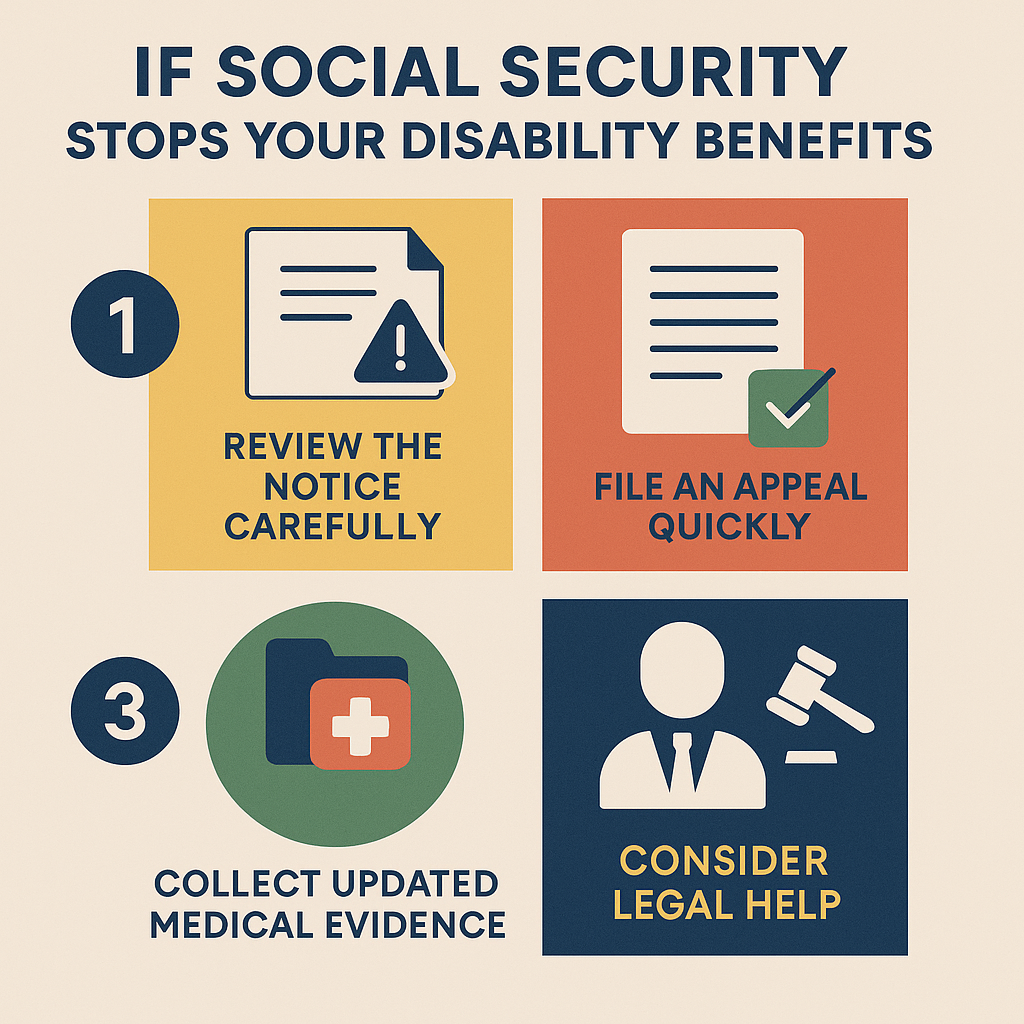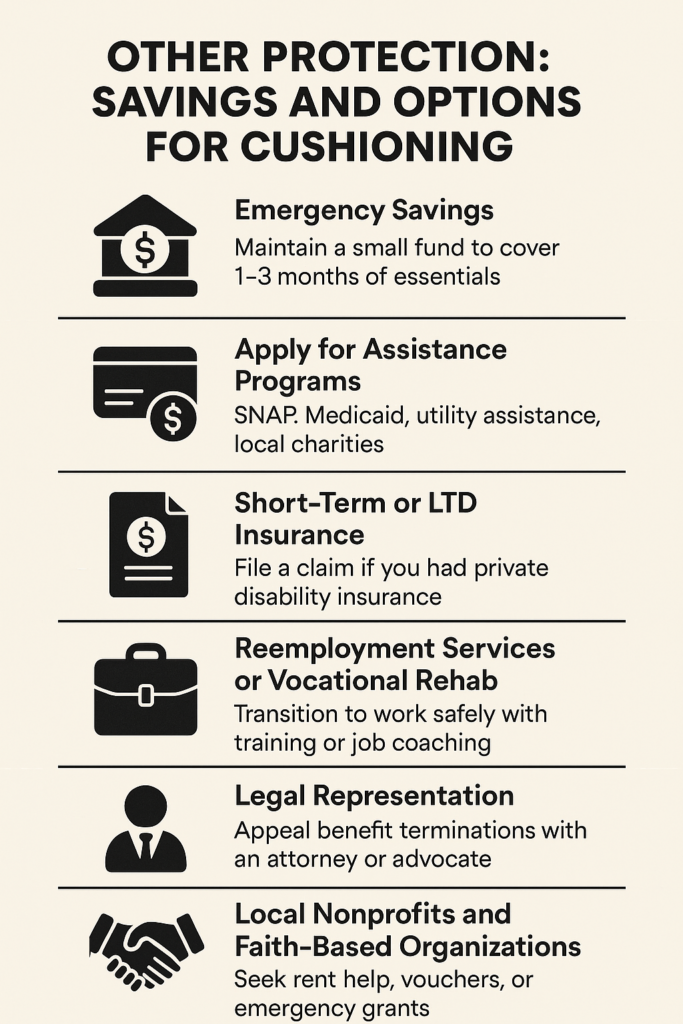If Social Security decides to stop your disability benefits, you still have options — but timing is critical. Here’s what to do step by step:

1. Review the Notice Carefully
The letter from the Social Security Administration should explain why they are stopping your benefits and what deadlines apply. Do not ignore this notice — the clock starts ticking as soon as you receive it.
2. File an Appeal Quickly
You have 60 days from the date on the letter to file a Request for Reconsideration. If you miss that deadline, you may lose the chance to appeal.
To continue receiving your monthly disability benefit checks while you appeal, you must:
- Submit the appeal within 10 days, and
- Check the box on the form that says you want your benefits to continue during the appeal.
3. Collect Updated Medical Evidence
If your condition has not improved, it is crucial to show that to them:
- Continue seeing your doctors regularly
- Request updated medical records
- Ask your providers for statements about how your condition affects your ability to work
4. Consider Legal Help
You are not required to have an attorney, but representation can greatly improve your chances of keeping your disability benefits. We are happy to assist you through this process, including preparing your appeal and representing you at a hearing if necessary.
Why SSDI Benefits Are Terminated

1.  Medical Improvement
Medical Improvement
Most common reason.
Social Security Administration finds that:
- Your condition has medically improved, and
- You’re now able to work at a substantial level
This is usually decided during a Continuing Disability Review (CDR).
2.  Working Above Substantial Gainful Activity (SGA)
Working Above Substantial Gainful Activity (SGA)
- In 2025, if you’re earning more than $1,620/month (non-blind) or $2,700/month (blind), SSA may consider you no longer disabled
- Even part-time work can cause concern if earnings or duties suggest you can work full-time
3.  Failure to Cooperate
Failure to Cooperate
SSA may stop disability benefit payments if you:
- Don’t return review forms (SSA-454 or SSA-455)
- Miss a consultative exam (CE)
- Fail to provide updated medical information
4.  Incarceration or Institutionalization
Incarceration or Institutionalization
Social Security benefits are usually suspended or terminated if:
- You are in jail or prison for 30+ days
- You are in a public institution without eligibility for benefits
5.  Fraud or Misrepresentation
Fraud or Misrepresentation
SSA can terminate benefits if they discover:
- You gave false information
- Someone else received payments fraudulently on your behalf
6.  Reaching Retirement Age
Reaching Retirement Age
SSDI benefits automatically convert to Social Security Retirement benefits when you reach full retirement age (currently 66–67, depending on birth year)
How to Reinstate SSDI Benefits
If your SSDI benefits were stopped (due to medical improvement, returning to work, or missed paperwork), you may be able to get them restarted — depending on your situation.
 Option 1: Expedited Reinstatement (EXR)
Option 1: Expedited Reinstatement (EXR)
If your benefits were stopped because of work and earnings, EXR allows you to quickly restart benefits without reapplying.
To Qualify for EXR:
- Your benefits stopped within the last 5 years
- You stopped working or your income dropped below SGA
- Your original disabling condition (or a related one) is still limiting you
Benefits of EXR:
- You can get provisional (temporary) payments for up to 6 months while SSA reviews your case
- No need to file a new application

- File an Expedited Reinstatement request (Form SSA-371)
- Provide current medical records
- SSA will conduct a medical review to confirm continued disability
 Option 2: File a New Application
Option 2: File a New Application
If you don’t qualify for EXR (e.g., too much time has passed or the condition is new), you can:
- Reapply for SSDI from the beginning
- You’ll go through the full disability evaluation process again

| Situation | Best Option |
| Benefits stopped due to work, within 5 years | Expedited Reinstatement (EXR) |
| New medical condition or too much time has passed | File a new SSDI application |
| Unsure or denied | Appeal or get legal help |
 Important Reminders
Important Reminders
- Keep documentation of why your benefits stopped
- Gather medical evidence and work history
- If SSA says no to reinstatement, you can appeal — just like a new claim
 Get Help if You Need It
Get Help if You Need It
An experienced disability attorney or representative can:
- Help determine if you qualify for EXR
- Assist with forms and medical evidence
Other Protection: Savings and Options for Cushioning

If your SSDI benefits are cut off or delayed, it’s important to know what other resources might help you stay afloat. Consider the following strategies to cushion the financial impact
 1. Emergency Savings
1. Emergency Savings
- If possible, maintain a small emergency fund to cover 1–3 months of essentials (rent, food, utilities)
- Keep funds easily accessible in a no-fee checking or savings account
 2. Apply for Assistance Programs
2. Apply for Assistance Programs
- SNAP (food stamps)
- Medicaid or state health coverage
- Utility assistance programs (LIHEAP)
- Local food banks and housing agencies
 3. Short-Term Disability or Long-Term Disability (LTD) Insurance
3. Short-Term Disability or Long-Term Disability (LTD) Insurance
- If you had private disability insurance through an employer or on your own, you may be able to file a claim or reactivate a policy
 4. Reemployment Services or Vocational Rehab
4. Reemployment Services or Vocational Rehab
- If benefits stopped due to improvement or work activity, programs like Vocational Rehabilitation (VR) can help you transition to work safely — sometimes with job coaching, retraining, or assistive devices
 5. Legal Representation
5. Legal Representation
- A disability attorney or advocate can help you appeal benefit terminations and seek expedited reinstatement if you’re eligible
 6. Local Nonprofits and Faith-Based Organizations
6. Local Nonprofits and Faith-Based Organizations
- Many offer rent help, transportation vouchers, or small emergency grants while you’re in appeal or transition
Losing SSDI benefits — even temporarily — can be overwhelming, but you are not without support. Building even a small safety net, exploring public assistance, and knowing your legal rights can help you stay stable while you work toward reinstatement or appeal. If your benefits are cut, act quickly, stay organized, and don’t hesitate to ask for help — financial, legal, or emotional. You don’t have to face it alone.
At Benefits.com, we are here to help you navigate the process and receive the benefits you deserve. Begin today by taking our free eligibility quiz.
 Benefits.com Advisors
Benefits.com Advisors
With expertise spanning local, state, and federal benefit programs, our team is dedicated to guiding individuals towards the perfect program tailored to their unique circumstances.
Rise to the top with Peak Benefits!
Join our Peak Benefits Newsletter for the latest news, resources, and offers on all things government benefits.


















